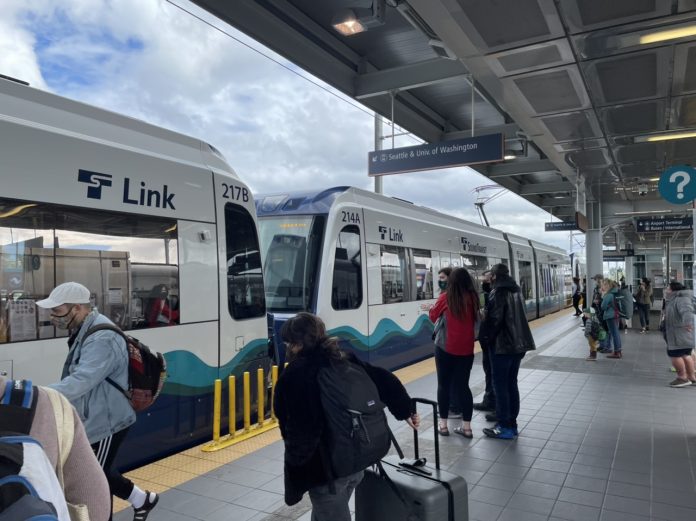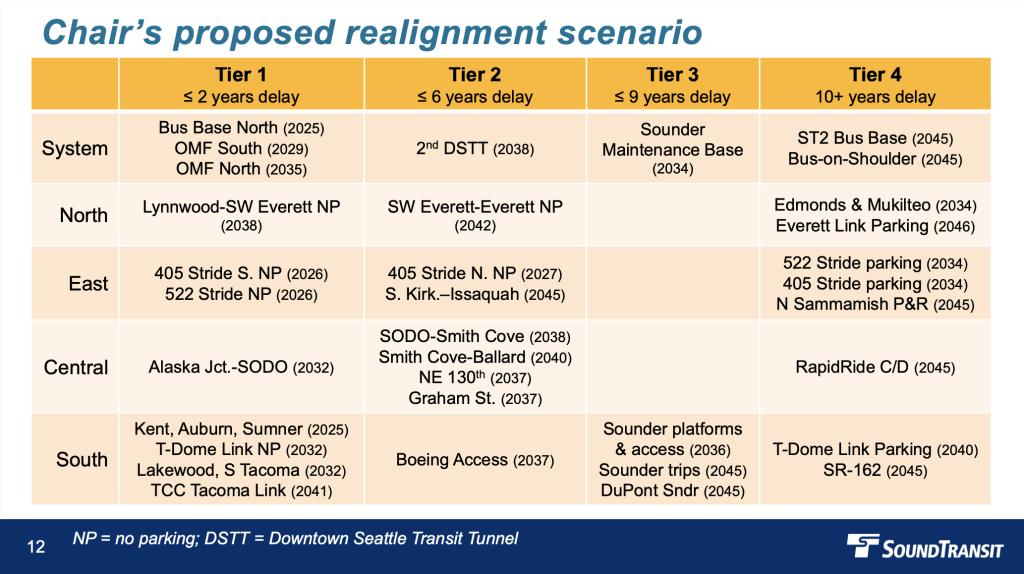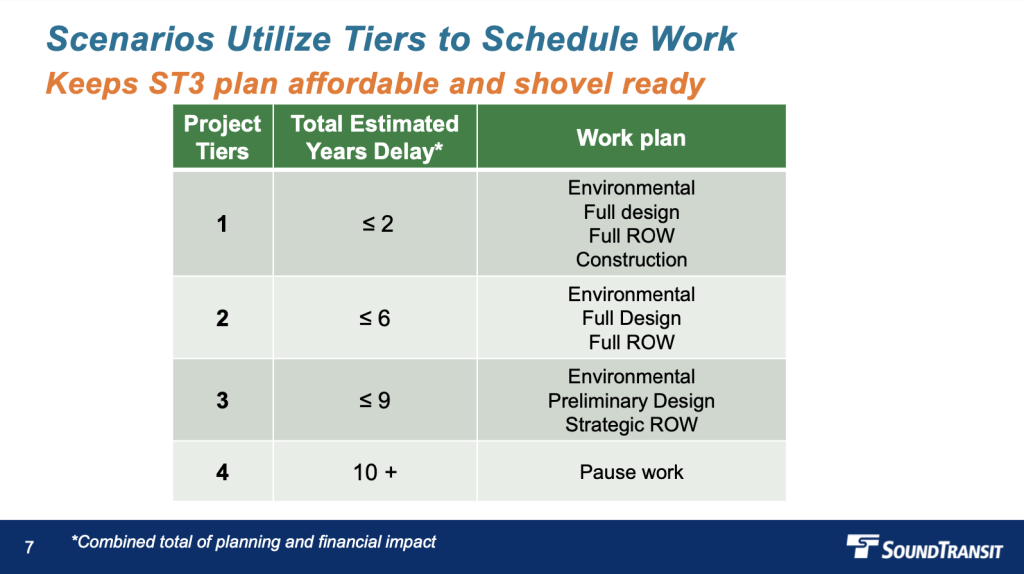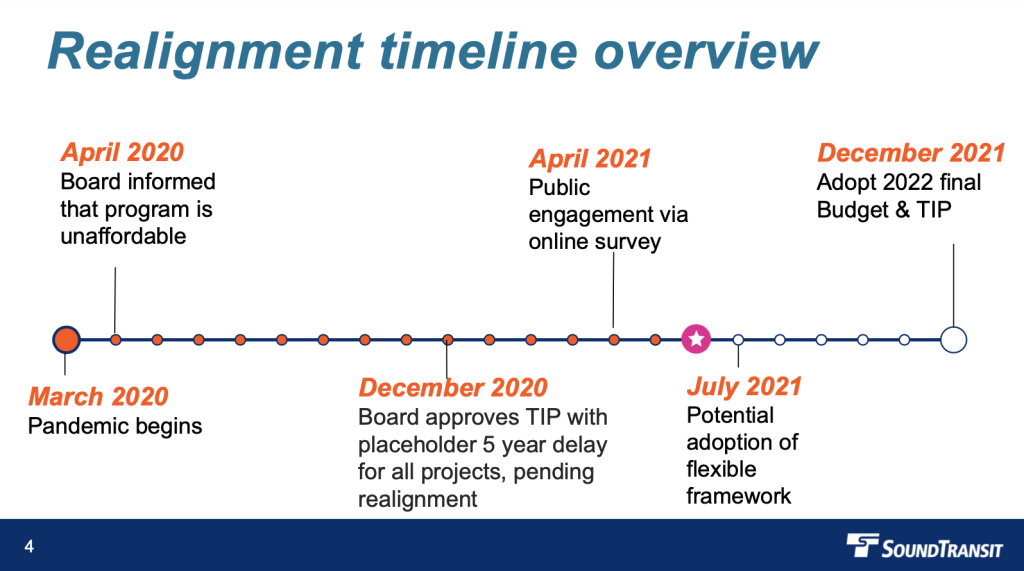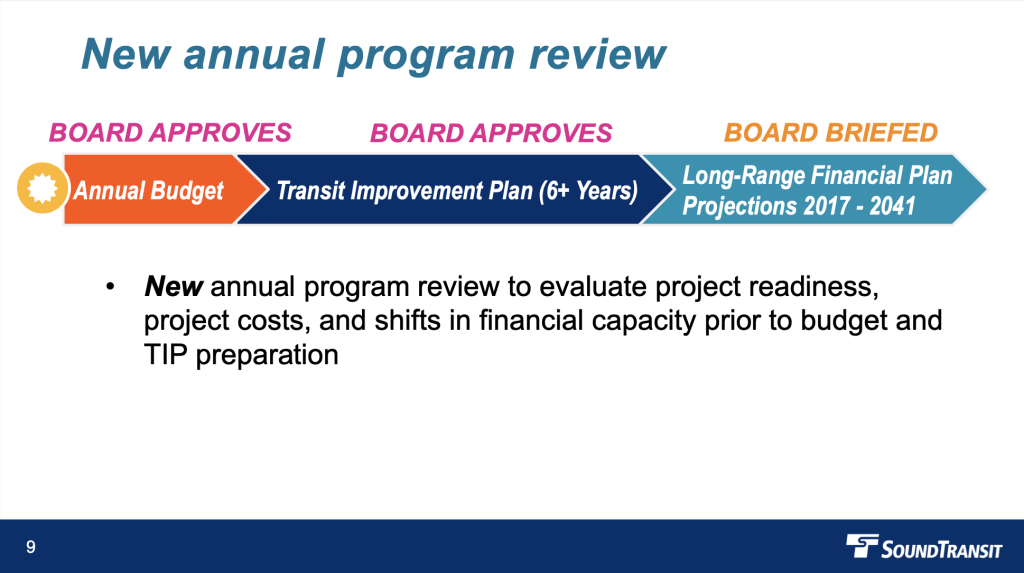A draft plan submitted to the Sound Transit board of directors would cement the delay of Sound Transit 3 (ST3) voter-approved transit expansion projects by years, which accedes to the fact that the agency faces a $7.9 billion affordability gap. The plan championed by the board’s chair, University Place Councilmember Kent Keel, puts less delay of light rail expansion along the I-5 corridor from Everett to Tacoma than higher ridership alignments and productive infill stations. It also places Stride bus rapid transit (BRT) projects as early deliverables in the delayed program. Projects in Seattle — with the exception of light rail from Alaska Junction to SODO — take a backseat in the plan with larger delays of three to 21 years.
Draft realignment plan proposes years of delay, may advance insular interests
Before unveiling the draft realignment plan, Sound Transit staff emphasized that the realignment scenarios are accounting for both financial and planning impacts to timelines. Agency staff said that active projects in the environmental review phase are expected to incur delays. Many of these are seeing about two years of delay because of pandemic impacts on partner agencies, though that math likely raises more questions than it answers since the pandemic has only been impacting the region for one year and three months.
In delivering the draft realignment plan, Keel said, “I do believe this proposal is the best attempt at capturing the priorities that have been articulated to me from boardmembers and stakeholders.” In adding to this, Keel justified the plan’s framework and premise. “The proposal underscores and anticipates we will do everything we can to increase our financial capacity as quickly as possible,” he said. “The flexibility of our proposal allows us to speed up the delivery of projects as our capacity allows. It keeps faith with the voters by delivering as much as we can as soon as we can as we are given affordability.”
Keel said that his proposal would deliver on board-adopted realignment criteria, such as completing the I-5 light rail spine from Everett to Tacoma, moving forward on projects that have strong ridership potential, finishing projects that had the longest tenure (i.e., Sound Transit 2 projects), and prioritizing equity for transit-dependent, diverse, and low-income communities. Though with eight distinct pieces of criteria and no public matrix or model, it’s hard to know how the realignment plan really stacks up without futilely trying to piece together vague benchmarks. Nevertheless, Keel emphasized that the realignment proposal would allow the agency “to deliver new light rail extensions and open Stride BRT as quickly as possible.” The consequence of this, he said, is that “it temporarily defers most other investments, including ST3 Sounder…and parking investments.”
The latter point Keel made is significant because parking projects in Sound Transit 3 (ST3) represent about a $1 billion in costs. Moving those largely to the end of the line — with the exception of ST2 parking projects at Sounder stations like Kent, Auburn, and Sumner — expands financial capacity early in the realignment timeline for more transit projects. This, of course, is a fraught concept by some suburban interests, but suburban boardmembers in South King County and Pierce County would still get their Sounder station parking.
A deal that Keel was able to strike for Snohomish County allows for the first ST3 extension toward Everett to reach the Southwest Everett area around Paine Field and Boeing Everett. This extends the line further than other phased concepts that would have only extended the initial segment to Mariner around 128th St SW, but comes with a slight additional delay to do it. Though wiser transit investments could deliver light rail to Everett sooner if the high cost and poor ridership Paine Field deviation were dropped and replaced with BRT.
Aside from the fact that Seattle’s major light rail extensions are proposed to be delayed up to five years, Keel’s plan inexplicably puts the RapidRide C and D Line project at the back of the line and puts Seattle infill stations in Tier 2 in a four-tiered realignment plan.
For its part, the RapidRide C and D Line project only costs several tens of millions of dollars and was planned to be delivered in 2024. Keel’s plan sends that project back to 2045, a full 21 years later and raising the very real possibility it will never be funded. The project effectively is a financial rounding error.
As for the infill stations, all three projects at Graham Street, NE 130th Street, and Boeing Access Road have their merit. Residents and businesses in the Rainier Valley, many being low-income or Black, Indigenous, and people of color (BIPOC), have been awaiting a new station at Graham Street for years, but Keel’s plan would push that back another six years to 2037. Businesses in the industrial area have also been adamant that the station at Boeing Access Road is needed to provide better transit access to the area and nearby neighborhoods, yet that too is delayed six more years in Keel’s plan to 2037. But perhaps most surprising is the additional six-year delay for the station at NE 130th Street, which would also open in 2037. Sound Transit has already spent a significant sum of money to engineer and construct a ghost station box there as part of the Lynnwood Link extension, an ST2 project. Completing the project to open years earlier than the original 2031 date set in ST3 wouldn’t cost that much money and could be an early win, yet Keel’s plan does the opposite.
All in all, Keel’s plan is fairly at odds with public commenters — and there were a tremendous sum of them — who generally urged the board to deliver the full ST3 program on or very near project timelines proposed to voters in 2016, though BRT projects did find extensive political support from public officials up and down the I-405 and SR-522/SR-523 corridors. But most strikingly, Keel’s plan does have some features that make it seem like it’s geared toward creating insular political blocs to support it while pushing Seattle projects ever backward. After all, the federated board has 18 members, only six of whom have a direct or partial representative relationship with Seattle. Providing less severe delays to Stride BRT projects, the I-5 spine light rail projects, and ST2 parking projects certainly could garner wide support from other boardmembers.
| Sound Transit Board of Directors | 18 members |
| King County representatives | 10* |
| Pierce County representatives | 4** |
| Snohomish County representatives | 3 |
| WSDOT Secretary Roger Millar | 1* |
A more thorough realignment process or just an annual realignment check-in?
In a previous meeting, Seattle Mayor Jenny Durkan blasted the path that the board is on. “I think we are barreling toward making a decision that is probably one of the worst decisions that we could make as a board for the region and climate,” she said.
Durkan laid down salient points in a lengthy litany of criticisms. She pointed out that project delays are being incurred not because of lowered revenues — they have since mostly rebounded as the pandemic has ebbed and flowed — but because of project cost increases that the realignment process has not squarely dealt with. Because of this, the entire point of the realignment process has changed from dealing with declining revenues to dealing with project costs that were underestimated — a point consultants made last week showing that internal cost estimating failures were key culprits with 90% of them having nothing to do with real estate price inflation.
During the realignment process, the affordability gap has gone from a window of $7.8 billion to $12 billion in June 2020 — due to high revenue forecast uncertainty — to $11.5 billion in January 2021 to $7.9 billion in April 2021. And during that time, the board has not executed a plan of seriously pursuing interim state or local funding options, leaving that for down the road. On top of this, favorable federal funding circumstances could dramatically change very near on the horizon, new state economic projections show much higher levels of revenue, and refinancing existing Transportation Infrastructure Finance and Innovation Act (TIFIA) loans could net anywhere from $70 million to $380 million in savings all reducing the the affordability gap. So there are many pieces that could change the knowns and scope of needed realignment.
In rounding out her argument, Durkan said that realignment process timelines are being artificially constrained. Yet, Sound Transit contends that a sooner completion of the realignment process is a necessity. The agency’s position for completing the realignment process this summer rests on several practical reasons:
- Firstly, the agency has emphasized that there’s a basic legal requirement when the capital expansion plan becomes unaffordable, the board must take action to make it affordable. This, of course, is vague and one could construe that extension of the realignment process could still be seen as taking action to address the affordability problem and meeting the legal requirement. In fact, the board did just that last year by slowing down the snap realignment process.
- Secondly, the agency needs to be able to move forward with near-term project actions, which are difficult to program if realignment has not been achieved and could lead to delays. Sound Transit uses a complex gating system that advances projects into phases (e.g., planning, design, baselining, and construction) over the life of a project. Still, the board has been able to agree which near-term project actions should move forward this year.
- Thirdly, an affordable realignment plan will keep the agency’s credit rating high and make the agency eligible for federal funding. High credit ratings make debt sales more successful and lower borrowing costs because creditors are confident that Sound Transit can pay its debt reliably. Credible financial and capital investment plans are also necessary for Sound Transit to qualify for federal grants under the Federal Transit Administration’s Capital Investment Grant program. The federal agency wants to be assured that Sound Transit is capable of paying for its own portion of projects and proceed with a defined schedule.
So, does that mean the realignment process needs to wrap up this summer? That remains hotly contested.
Looking at the proposed realignment process more broadly, adoption of a realignment plan this summer would inform the annual budget for 2022 and six-year transit improvement plan (TIP) that will be adopted in December. Subsequent to this, the proposed realignment resolution would commission an annual program review program. That review process would involve evaluation of project readiness (e.g., third-party agreements, completion of environmental review, and right-of-way acquisition), project costs (e.g., estimated costs and cost saving opportunities), and financial capacity (e.g., forecasted revenues, grants, new financing tools, and debt capacity) changes prior to adoption of the annual budget and TIP in the fall. In essence, this process would allow the board to revisit project timelines to move them forward or backward based upon updated financial information.
An alternative realignment plan
During last week’s meeting, King County Councilmember Claudia Balducci (District 6, Bellevue) said that she was planning to bring forward her own realignment alternative. “I do want to just share for the board and others that I have been working with [agency planning and project development staff] to put together a slightly modified alternative proposal for realignment that is predicated on maintaining schedule as close as possible,” she said. “We are closing in on something that I believe that can be shared.” Balducci added that she didn’t want to share half completed work, which could cause confusion, but that it should be ready fairly soon. Once it’s out, she hopes the board will consider it and weigh its merits.
“I just feel it’s really important for us to try to look at an alternative that would lean into schedule,” she concluded.
Next steps
In a timeline presented to the board, the remaining process to select a final realignment plan could wrap up by July 22nd. An Executive Committee is anticipated to happen on July 1st where boardmembers would consider a resolution and discuss amendments. Actual amendments would need to be prepared and transmitted to the chair by July 8th. Then on July 15th, a Finance and Audit Committee meeting is expected to be held to discuss the financial aspects of the resolution and review updated financial conditions. All of this could culminate in final board action to adopt a realignment plan resolution on July 22nd.
Stephen is a professional urban planner in Puget Sound with a passion for sustainable, livable, and diverse cities. He is especially interested in how policies, regulations, and programs can promote positive outcomes for communities. With stints in great cities like Bellingham and Cork, Stephen currently lives in Seattle. He primarily covers land use and transportation issues and has been with The Urbanist since 2014.


